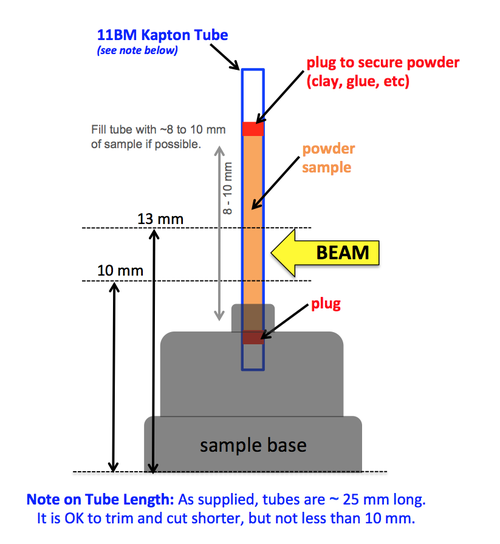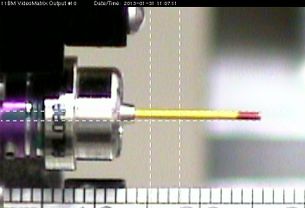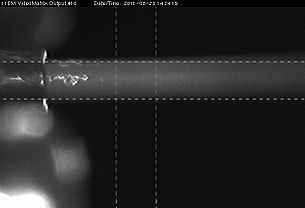Difference between revisions of "Mail-In Powder Diffraction Measurements"
| (26 intermediate revisions by the same user not shown) | |||
| Line 1: | Line 1: | ||
== Safety and Training == | |||
Review [https://wiki-ext.aps.anl.gov/ug11bm/index.php/Hazards#Mail-in_Measurments sample hazard restrictions]for mail-in experiments. | |||
Be aware of APS safety and training guidelines | |||
[https://www.aps.anl.gov/Safety-and-Training www.aps.anl.gov/Safety_and_Training/] | |||
Many APS rules apply only to on-site users, but Mail-In users should review notes for Experiment Hazard Classes and restrictions on the shipping of samples. | |||
== Kapton Tubes for Mail-In Measurements == | |||
The supplied Kapton capillary tubes for 11-BM mail-in experiments have an inner diameter of 0.80 mm, and an outer diameter that fits snugly inside 11-BM mounting bases. | |||
See [https://wiki-ext.aps.anl.gov/ug11bm/index.php/Supplies_and_Tools#Capillaries:_Kapton more details on Kapton capillary tubes] | |||
'''Note:''' All sample powders must be fully contained and secured within these capillary tubes. | |||
== Nesting Capillaries inside Kapton Tubes == | == Nesting Capillaries inside Kapton Tubes == | ||
Some mail-in samples may require additional glass or fused quartz capillary tubes nested inside the standard | Some mail-in samples may require additional glass or fused quartz capillary tubes nested inside the standard Kapton tube. | ||
Any additional capillary must fit and be secured entirely inside the supplied Kapton tube. | |||
If returning samples loaded in glass capillaries, please '''leave a note''' in the package so we be sure to take extra care when handling. | |||
See the | See the [https://wiki-ext.aps.anl.gov/ug11bm/index.php/Nesting_Glass/Quartz_Capillaries_in_Kapton_Tubes Instructions on Nesting Capillaries]. | ||
This can be useful for samples which are: | |||
*Air Sensitive ([https://wiki-ext.aps.anl.gov/ug11bm/index.php/Air_Sensitive_Samples more info]) | |||
*X-ray Absorbing ([https://wiki-ext.aps.anl.gov/ug11bm/index.php/X-ray_Absorption_and_Fluorescence more info]) | |||
'''Note:''' 11-BM does not provide glass or quartz capillaries for mail-in experiments. Only Kapton tubes (with an inner diameter of 0.81 mm) are provided for the mail-in service. See the Wiki for more info (vendors etc) on [https://wiki-ext.aps.anl.gov/ug11bm/index.php/Supplies_and_Tools#Capillaries:_Thin_Wall_Glass_and_Fused_Quartz glass or fused quartz capillaries]. | |||
==Beam Size and Position== | |||
[[image:SampleBase_Diagram.png|500px|Properly prepared sample for the 11-BM mail-in service]] | |||
[[image:upstream.jpg|305x240px|Sample view through the "upstream" camera.]] | [[image:upstream.jpg|305x240px|Sample view through the "upstream" camera.]] | ||
| Line 24: | Line 41: | ||
Two views of a sample in position for data-taking, as seen through the "upstream" camera (left) and the video microscope (right). The reticle lines show the nominal extent of the beam. The actual beam edges extend somewhat farther, so these areas should be kept clear of foreign material (glue, clay, wax, etc.). The sample material must be held in place in the beam -- if it is loose in the capillary, it will move when we spin the capillary (we spin at about 5400 r.p.m.). In addition, there must be no lumps of material at the end of the capillary, since this could cause the capillary to bend or break during spinning, and such a lump may also cause a robot malfunction when it attempts to load or unload the sample. | Two views of a sample in position for data-taking, as seen through the "upstream" camera (left) and the video microscope (right). The reticle lines show the nominal extent of the beam. The actual beam edges extend somewhat farther, so these areas should be kept clear of foreign material (glue, clay, wax, etc.). The sample material must be held in place in the beam -- if it is loose in the capillary, it will move when we spin the capillary (we spin at about 5400 r.p.m.). In addition, there must be no lumps of material at the end of the capillary, since this could cause the capillary to bend or break during spinning, and such a lump may also cause a robot malfunction when it attempts to load or unload the sample. | ||
== Tools == | == Tools == | ||
User may find some of the following tools helpful when preparing samples: | User may find some of the following tools helpful when preparing samples: | ||
*'''Small Drill Bits''' can be useful for loading & packing powder inside Kapton tubes [https://wiki-ext.aps.anl.gov/ug11bm/index.php/ | *'''Small Drill Bits''' can be useful for loading & packing powder inside Kapton tubes [https://wiki-ext.aps.anl.gov/ug11bm/index.php/Supplies_and_Tools#Drill_Bits (more details)] | ||
*'''Powder Sieves''' help remove any large particles and ensure homogeneous powders [https://wiki-ext.aps.anl.gov/ug11bm/index.php/ | *'''Powder Sieves''' help remove any large particles and ensure homogeneous powders [https://wiki-ext.aps.anl.gov/ug11bm/index.php/Supplies_and_Tools#Powder_Sieves (more details)] | ||
* '''Mortar & Pestles''' Agate mortars and pestles are invaluable tools for grinding powder samples [https://wiki-ext.aps.anl.gov/ug11bm/index.php/ | * '''Mortar & Pestles''' Agate mortars and pestles are invaluable tools for grinding powder samples [https://wiki-ext.aps.anl.gov/ug11bm/index.php/Supplies_and_Tools#Mortar_and_Pestle (more details)] | ||
Latest revision as of 18:31, 22 April 2020
Safety and Training
Review sample hazard restrictionsfor mail-in experiments.
Be aware of APS safety and training guidelines www.aps.anl.gov/Safety_and_Training/
Many APS rules apply only to on-site users, but Mail-In users should review notes for Experiment Hazard Classes and restrictions on the shipping of samples.
Kapton Tubes for Mail-In Measurements
The supplied Kapton capillary tubes for 11-BM mail-in experiments have an inner diameter of 0.80 mm, and an outer diameter that fits snugly inside 11-BM mounting bases.
See more details on Kapton capillary tubes
Note: All sample powders must be fully contained and secured within these capillary tubes.
Nesting Capillaries inside Kapton Tubes
Some mail-in samples may require additional glass or fused quartz capillary tubes nested inside the standard Kapton tube.
Any additional capillary must fit and be secured entirely inside the supplied Kapton tube.
If returning samples loaded in glass capillaries, please leave a note in the package so we be sure to take extra care when handling.
See the Instructions on Nesting Capillaries.
This can be useful for samples which are:
Note: 11-BM does not provide glass or quartz capillaries for mail-in experiments. Only Kapton tubes (with an inner diameter of 0.81 mm) are provided for the mail-in service. See the Wiki for more info (vendors etc) on glass or fused quartz capillaries.
Beam Size and Position
Two views of a sample in position for data-taking, as seen through the "upstream" camera (left) and the video microscope (right). The reticle lines show the nominal extent of the beam. The actual beam edges extend somewhat farther, so these areas should be kept clear of foreign material (glue, clay, wax, etc.). The sample material must be held in place in the beam -- if it is loose in the capillary, it will move when we spin the capillary (we spin at about 5400 r.p.m.). In addition, there must be no lumps of material at the end of the capillary, since this could cause the capillary to bend or break during spinning, and such a lump may also cause a robot malfunction when it attempts to load or unload the sample.
Tools
User may find some of the following tools helpful when preparing samples:
- Small Drill Bits can be useful for loading & packing powder inside Kapton tubes (more details)
- Powder Sieves help remove any large particles and ensure homogeneous powders (more details)
- Mortar & Pestles Agate mortars and pestles are invaluable tools for grinding powder samples (more details)


